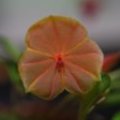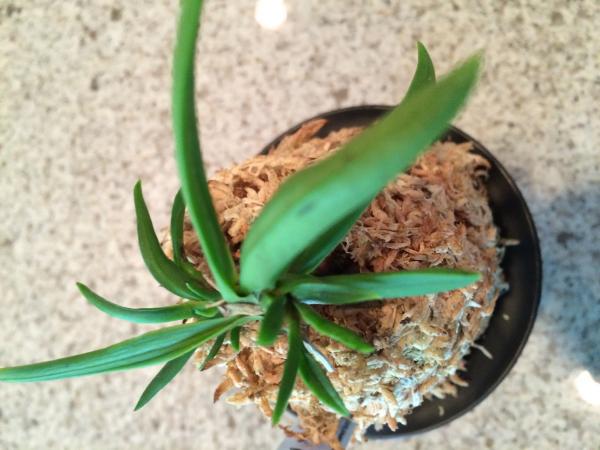


Donate Now
and become
Forum Supporter.

Many perks!
<...more...>


|

01-11-2016, 02:37 AM
|
|
Senior Member
|
|
Join Date: Nov 2011
Posts: 7,196
|
|
 Which Vandas Have Spots on their Leaves?
Which Vandas Have Spots on their Leaves?
I noticed that my Ascofinetia Cherry Blossom and Neostylis Pinky have dark purple spots and marks of random shapes.
I just recently bought Vascostylis Pearl Cooper (Rhyncostylis x Vanda Pralor).
It is mostly plain green but I notice that a couple of leaves have some black spots. They are not sunken and do not appear to be the dreaded this diamond fungal diseas spots that are all too common on large vandas.
So, I'm curious.
I don't think Rhyncostylis is spotted. At least the ones I saw did not. Maybe it varies since my neostylis has spots but neos do not have spots.
|

01-11-2016, 12:37 PM
|
 |
Senior Member
|
|
Join Date: Aug 2013
Zone: 7a
Location: North Plainfield, NJ
Posts: 2,817
|
|
Rhy gigantea can have some markings on the leaves (in particular if the 'red' variety is used). Ascocentrum ampullaceum (used in Cherry Blossom) has a lot of pigment in the leaves.
__________________
Kim (Fair Orchids)
Founder of SPCOP (Society to Prevention of Cruelty to Orchid People), with the goal of barring the taxonomists from tinkering with established genera!
I am neither a 'lumper' nor a 'splitter', but I refuse to re-write millions of labels.
|

01-11-2016, 01:19 PM
|
 |
Senior Member
|
|
Join Date: Jun 2012
Zone: 9b
Location: SF Bay Area, CA
Posts: 2,325
|
|
There are Neos with "sumi" spots. I don't know which ones off hand, perhaps the experts will chime in.
__________________
Anon Y Mouse
"Never attribute to malice that which is adequately explained by stupidity." Hanlon’s Razor
I am not being argumentative. I am correcting you!
LoL Since when is science an opinion?
|

01-11-2016, 02:30 PM
|
|
Senior Member
|
|
Join Date: Jun 2015
Zone: 9a
Location: Texas
Posts: 199
|
|
I have a neo with sumi spots. It's Neo. Shishikouryu.
Sorry for the somewhat fuzzy pic. You can see the black stripes and dots on the closest leaf.

Last edited by Yazz; 01-11-2016 at 02:39 PM..
|

01-11-2016, 03:16 PM
|
 |
Senior Member
|
|
Join Date: Jun 2015
Zone: 9b
Location: Phoenix AZ - Lower Sonoran Desert
Posts: 18,534
|
|
In correspondence Martin Motes told me that purple coloring and spotting on Vanda alliance plants mostly represents magnesium deficiency, especially if it's more prominent during cooler weather. I started adding Epsom salts to my fertilizer regimen and an Ascocentrum christiansonianum x ampullaceum from him, which had developed LOTS of purple spots when the weather cooled, now has new growth without the spots.
|
|
Post Thanks / Like - 2 Likes
|
|
|
|
|

01-12-2016, 01:14 AM
|
|
Senior Member
|
|
Join Date: Nov 2011
Posts: 7,196
|
|

Thanks, Kim!
That explains the spots on my Ascof. Cherry Blossom.
The rhynchostylis parent of my new vascostylis is the blue form, rhynchostylis coelestis. I have see a few plants of this and it had no spots. Probably spots might come from the parent? hmm
Regarding the spots on the neo, can you try a clearer photo? I think the most important part ( where the mark or spot is) is blurred in the picture, is it not??
I have seen some example pictures before, but I cannot really tell the difference between those and the fungal diseases marks.
---------- Post added at 12:14 AM ---------- Previous post was at 12:11 AM ----------
Sorry, the main spots I'm talking about here are not the same as the ones you are referring to.
They are black, not purple, on my new vascostylis.
I often see this purple pigmentation on certain cattleyas, but not on vandas.
Quote:
Originally Posted by estación seca

In correspondence Martin Motes told me that purple coloring and spotting on Vanda alliance plants mostly represents magnesium deficiency, especially if it's more prominent during cooler weather. I started adding Epsom salts to my fertilizer regimen and an Ascocentrum christiansonianum x ampullaceum from him, which had developed LOTS of purple spots when the weather cooled, now has new growth without the spots.
|

|

01-12-2016, 08:06 AM
|
 |
Senior Member
|
|
Join Date: Aug 2013
Zone: 7a
Location: North Plainfield, NJ
Posts: 2,817
|
|
Quote:
Originally Posted by estación seca

In correspondence Martin Motes told me that purple coloring and spotting on Vanda alliance plants mostly represents magnesium deficiency, especially if it's more prominent during cooler weather. I started adding Epsom salts to my fertilizer regimen and an Ascocentrum christiansonianum x ampullaceum from him, which had developed LOTS of purple spots when the weather cooled, now has new growth without the spots.
|
While I recognize Martin as an authority, I think that we are talking about different kinds of spots. Certain species commonly have pigment in the foliage, while most others do not (when all are grown under same conditions).
__________________
Kim (Fair Orchids)
Founder of SPCOP (Society to Prevention of Cruelty to Orchid People), with the goal of barring the taxonomists from tinkering with established genera!
I am neither a 'lumper' nor a 'splitter', but I refuse to re-write millions of labels.
|

01-12-2016, 08:13 PM
|
|
Senior Member
|
|
Join Date: Jun 2015
Zone: 9a
Location: Texas
Posts: 199
|
|
Hope this is better...
Neo. Shishikouryu.
This unique species has a strong bending of leaves, as well as the rough texture of the leaf, which is called Koureuba. The black markings on the leaves are called ink spots, or "sumi." Tsuke is different for each growth, as "ocean wave" or "direct."

These are not fungal or disease marks.
Last edited by Yazz; 01-12-2016 at 08:24 PM..
|

01-16-2016, 10:03 PM
|
|
Senior Member
|
|
Join Date: Nov 2011
Posts: 7,196
|
|
hmmm clearer shot, but still hard to identify exactly what I'm looking at.
I do see tiny black spots and one bar mark on one of the two longer leaves on the left.
I have heard about these sumi spots, but am not familiar with them still.
|
|
Post Thanks / Like - 1 Likes
|
 Yazz
Yazz liked this post
|
|
|

01-19-2016, 09:37 PM
|
|
Senior Member
|
|
Join Date: Jun 2015
Zone: 9a
Location: Texas
Posts: 199
|
|
Welcome to the world of Neos. When you thought you have seen it all, something else pops up.
FWIW, I have a 1944 V. christensoniana x V ampullacea that gets freckles, and a 1823 V t.Tessellata 'T orchids' x V. testacea that has no freckles. Both from Motes, same culture and light, southern window. Go figure...
|
|
Tags
|
spots, rhyncostylis, neostylis, vandas, leaves, diseas, common, fungal, dreaded, diamond, varies, neos, curious, spotted, bought, recently, vascostylis, pearl, ascofinetia, cooper, shapes, dark, pinky, purple, marks  |
|
Currently Active Users Viewing This Thread: 1 (0 members and 1 guests)
|
|
|
 Posting Rules
Posting Rules
|
You may not post new threads
You may not post replies
You may not post attachments
You may not edit your posts
HTML code is Off
|
|
|
All times are GMT -4. The time now is 12:51 AM.
|

































 Linear Mode
Linear Mode


